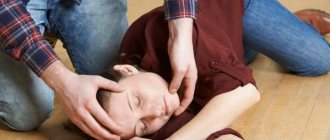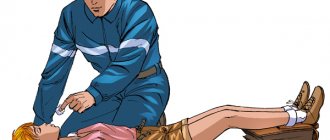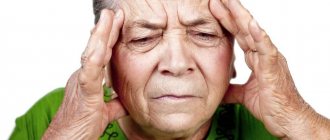What is vasovagal syncope
A short-term loss of consciousness with vasovagal syncope occurs when a person takes an upright position. Such phenomena occur due to stimulation of the vagus nerve, which innervates the chest, neck and intestines.
Vasovagal syncope occurs when a person is in an upright position at a time when, due to stimulation of the vagus nerve, the lumen of the blood vessels dilates and the pulse rate decreases.
The cause is usually stress, severe emotional shock, hunger, and external influences.
For differential diagnosis of serious diseases, a comprehensive examination is carried out, including 24-hour monitoring of heart function.
Treatment is aimed at combating the cause of fainting.
Like other types of fainting, vasovagal fainting develops against the background of a sharp decrease in blood flow to the brain due to the influence of a number of provoking factors: stress, nervous tension, fear, and others.
Loss of consciousness occurs due to the fact that the described processes contribute to the dilation of blood vessels, which leads to a decrease in blood pressure and heart rate (bradycardia). As a result, the brain experiences oxygen starvation.
If you notice symptoms of impending vasovagal syncope, you should lie down and loosen tight clothes, a tie, or a belt.
In most cases, the person immediately feels better. To speed up recovery, you can raise your legs above your head.
Neurologist, reflexologist, hirudotherapist
Kislitsyna Ekaterina Nikolaevna
10 years of experience
Kinds
In medicine, it is customary to divide vasovagal syncope into two types.
Classical
Loss of consciousness is accompanied by phenomena characteristic of other types of fainting states. Most often, the classic type occurs against the background of emotional disturbances (fear, strong emotions, etc.), or prolonged stay in an upright position. It is detected mainly in young people under 30 years of age.
Non-classical
This type of vasovagal syncope is diagnosed in cases where it is impossible to determine the provoking factor. Loss of consciousness in this scenario occurs mainly in older people.
Risk factors
The reflex that causes vasovagal syncope can occur to some degree in everyone, so almost anyone can experience a vasovagal episode if a strong enough trigger event occurs. Indeed, it is likely that most people will experience an episode of fainting at some time during their lifetime.
Vasovagal syncope can occur at any age, but it is much more common in adolescents and young adults than in older adults.
Some people are particularly prone to vasovagal episodes and may lose consciousness even with relatively mild triggers. These people tend to have periodic fainting beginning in adolescence. They often experience fainting after several different types of triggers.
In rare cases in people, vasovagal syncope is so common and so difficult to treat that the person is effectively disabled. These people often have a form of dysautonomia (autonomic nervous system imbalance) that makes them very prone to the vasovagal reflex that causes this condition.
They often have other symptoms typical of dysautonomia, such as bloating or cramping, diarrhea, constipation, extreme fatigue and various aches and pains.
Causes
The main cause of vasovagal syncope is an abnormal reaction of the body to the influence of the external environment, which has a stimulating effect on the receptors of the autonomic nervous system. The latter is responsible for the functioning of internal organs.
Modern medicine has not fully elucidated the question of what changes in the body lead to loss of consciousness. Vasovagal syncope is thought to develop due to stimulation of the vagus nerve. This theory is supported by the fact that when such conditions occur, the heart rate decreases.
There is also an opinion that instantaneous inhibition of the sympathetic part of the nervous system, which regulates the autonomic system, can lead to loss of consciousness. This explains why blood vessels dilate during fainting.
Moreover, each of the processes described above is activated under the influence of one or more provoking factors:
- strong emotional stress arising from the sight of blood, due to fear, and so on;
- pain ;
- staying upright for a long period of time;
- abrupt cessation of physical exercise;
- wearing tight ties or collars;
- binge eating;
- long stay in a stuffy room, in a hot bath;
- dieting , fasting;
- abuse of bad habits;
- chronic state of fatigue;
- depression;
- heart pathologies;
- tumor formations.
People suffering from cardiovascular diseases are strongly advised not to stay in hot rooms or in direct sunlight for long periods of time. This situation contributes to impaired blood flow, resulting in changes in blood pressure.
Why can our articles be trusted?
We make health information clear, accessible and relevant.
- All articles are checked by practicing doctors.
- We take scientific literature and the latest research as a basis.
- We publish detailed articles that answer all questions.
Fainting due to prolonged fasting is caused by a lack of vitamins and microelements. The latter leads to a decrease in hemoglobin and blood sugar levels, resulting in a malfunction of internal systems.
Under the influence of stress of a different nature (physical and psycho-emotional), the body, trying to compensate for the lack of important elements, temporarily inhibits some of its functions.
Any bad habits negatively affect the condition of blood vessels, which increases the risk of malfunctions in the cardiovascular system. The result of such processes is vasovagal syncope. Similar phenomena occur with chronic lack of sleep and fatigue. In this case, fainting performs a compensatory function of the body, whose blood flow is disrupted.
Vasovagal syncope is only dangerous when there is a risk of injury to the head and limbs from a fall. In this case, sudden memory loss signals a malfunction in the functioning of the entire organism or its individual parts.
Symptoms
The development of vasovagal syncope occurs in two stages. Initially, several symptoms appear at once, indicating an imminent loss of consciousness:
- sudden pallor of the skin;
- intense cold sweat;
- loss of strength, which is initially observed in the limbs and then spreads to the whole body;
- dizziness;
- noise in ears;
- disorders of the gastrointestinal tract;
- pain appearing in the chest area;
- feeling of rapid heartbeat;
- the occurrence of tunnel vision, in which a person sees only those objects that are located in front;
- increase or decrease in heart rate.
The second stage is characterized by a short-term loss of consciousness. For some people, the symptoms described above do not ultimately lead to fainting.
Diagnostics
Doctors who know how to correctly diagnose vasovagal syncope understand that this condition is almost always situational. Vasovagal syncope is especially likely after a viral illness, after exercise, after a warm shower, or early in the morning—in other words, relative dehydration can occur at any time.
Given these characteristic features and the situational nature of this condition, doctors should be able to make a correct diagnosis simply by looking at symptoms, medical history, family history, and the sequence of events leading to syncope.
Physical examination of people with vasovagal syncope is usually completely normal. However, testing (such as an ECG) is very useful in diagnosing the similar conditions of orthostatic hypotension or postural orthostatic tachycardia syndrome (POTS) and can be very helpful in screening for likely candidates.
Diagnostic methods
After vasovagal syncope occurs, it is recommended to seek medical help, as sudden loss of consciousness may indicate serious problems in the functioning of the internal systems. In particular, these can be cardiovascular pathologies and malignant neoplasms.
Causes of loss of consciousness with convulsions
Convulsive fainting is one of the most common pathological conditions.
In order to establish the true cause that led to loss of consciousness, the doctor carries out the following measures:
- Gathering information about the patient’s current condition and main symptoms. In terms of establishing the causes of fainting, it is important to identify the initial phenomena that preceded the loss of consciousness.
- Analysis of the patient's life. The doctor asks about the patient’s professional responsibilities, concomitant pathologies and medications he is taking.
- Collection of information about family pathologies. This stage is important, since it has been established that vasovagal syncope in approximately 30% of cases is due to a hereditary predisposition.
- External examination of the patient, during which the condition of the skin and breathing rate are assessed. Additionally, the doctor listens to the lungs and heart.
- General analysis .
- chemistry . It allows you to determine the level of cholesterol, sugar, potassium and other elements.
If the latest tests did not show any abnormalities, then other diagnostic measures are additionally carried out aimed at identifying concomitant pathologies or excluding them.
Electrocardiography
It is prescribed to assess the performance of the heart muscle.
24-hour Holter electrocardiogram monitoring (HMECG)
The procedure lasts from 24 to 72 hours, during which ECG readings are regularly analyzed. Particular attention is paid to the changes that occur in the electrocardiogram during fainting.
Echocardiography
Vasovagal syncope does not affect echocardiography readings. This procedure is performed to exclude cardiac pathologies.
Orthostatic test (title test)
It is this examination method that allows us to detect vasovagal syncope. During the procedure, which lasts no more than half an hour, the patient is placed on a special bed set at an angle of 60 degrees. The patient is connected to a device through which the work of the heart muscle is assessed.
Additionally, blood pressure indicators are measured. After loss of consciousness, there is a sharp decrease in blood pressure and a short-term stop of heart contractions (a pause occurs).
If necessary, an examination by a neurologist is carried out. Electroencephalography and MRI, respectively, can exclude the presence of epilepsy and tumor, which can also provoke loss of consciousness.
Diagnosis – identifying the cause of fainting
Diagnosis consists of excluding causes not related to the vasovagal reaction. Of course, the operation is not always simple and, indeed, there is often a need to use a “protocol” of long-term examination, which can be formulated as follows:
- Electrocardiogram. To assess heart rate.
- Echocardiogram. To evaluate, using ultrasound, the functioning of the heart valves.
- Holter ECG. In order to shed light on the presence of hidden arrhythmia.
- Holter blood pressure monitoring for 24 hours. To track the progress of pressure over 24 hours.
- Standard blood tests. To test for diseases that may cause fainting, these may include anemia or diabetes.
- Encephalogram and MRI of the skull to exclude epilepsy, malformation and vascular problems.
- Tilt test. Practiced in the healthcare field, usually in the cardiology department. It consists of lying on a bed inclined at 60° for 45 minutes. This provokes a vasovagal crisis. After 20 minutes, if a crisis does not occur, the patient is given a drug (nitrate) that lowers blood pressure. The test is useful in assessing the causes of fainting.
Therapeutic measures
The treatment regimen for vasovagal syncope is determined based on the severity of the underlying disease. Therapeutic intervention is mainly used for patients who often experience short-term loss of consciousness.
In cases where the problem under consideration arises due to mental pathologies, the treatment regimen is determined depending on the status of the underlying disease.
Therapy for vasovagal syncope consists of several approaches.
Drug treatment
The patient is prescribed the following medications:
Self-medication is dangerous with complications!
Attention
Despite the fact that our articles are based on trusted sources and have been tested by practicing doctors, the same symptoms can be signs of different diseases, and the disease may not proceed according to the textbook.
Pros of seeing a doctor:
- Only a specialist will prescribe suitable medications.
- Recovery will be easier and faster.
- The doctor will monitor the course of the disease and help avoid complications.
find a doctor
Do not try to treat yourself - consult a specialist.
- Alpha adrenergic agonists. They contribute to the narrowing of blood vessels.
- Beta blockers. Such drugs block specific receptors in the body that are activated under the influence of stress hormones (adrenaline and norepinephrine).
- M-anticholinergics. Prescribed for the treatment of bradycardia.
Surgical intervention
Used in the presence of heart diseases and tumors. Surgical intervention, during which, if appropriate indications are available, a pacemaker is introduced, is carried out subject to the following conditions:
- age exceeds 40 years;
- vasovagal syncope occurs with regular frequency;
- absence of initial symptoms indicating imminent loss of consciousness;
- arrest was recorded .
Lifestyle change
You can prevent another loss of consciousness by following these recommendations:
- drink at least two liters of liquid per day;
- exclude heavy physical activity;
- avoid emotional stress;
- sleep at least eight hours a day;
- stop wearing tight underwear, replacing them with compression ones;
- regularly perform exercises aimed at strengthening your mental state.
Special isometric exercises are also used, through which you can increase blood pressure for a short period of time:
- Holding the ball in your hand, you need to squeeze your palm. The action promotes the outflow of venous blood.
- Hands clasp together and then forcefully pull in opposite directions.
- In a standing position, the legs are crossed, after which they must be tensed.
In case of sudden loss of consciousness, the person must be placed on his back with his legs raised above his head. This pose increases blood flow to the brain.
Vasovagal syncope is not dangerous to humans. It causes only two types of complications:
- injuries resulting from a fall;
- deterioration in quality of life in cases where fainting occurs frequently.
Preventive measures can help prevent another loss of consciousness.
Prevention measures
In order to prevent vasovagal fainting, first of all, it is necessary to avoid psycho-emotional stress. In particular, these include both conflict situations that can cause stress and prolonged stay in an upright position. At the same time, active outdoor activities are used as preventive measures to prevent loss of consciousness: walking, running, and so on.
You can also prevent the onset of another fainting spell:
- hardening or contrast shower (strengthens blood vessels);
- adherence to daily routine;
- duration is at least 8 hours;
- Regular consumption of herbal tea, red wine or coffee to restore blood pressure;
- drinking chamomile, lemon balm or St. John's wort tea, which has a positive effect on the nervous system.
Vasovagal syncope is not a dangerous phenomenon, which, however, may indicate serious pathologies: cardiovascular diseases, tumors. You can cope with such phenomena if you change your lifestyle.
Preventive measures
If any serious disease has not been diagnosed, then you need to seriously think about taking preventive measures, which include the following:
- you need to avoid situations that can provoke loss of consciousness;
- You can’t stay in the heat for a long time, fast, smoke, drink alcohol, or overwork;
- it is necessary to limit strong physical activity for three months;
- you need to improve your health - do light jogging in the morning, swimming, water aerobics;
- contrast showers and hardening have a positive effect on blood vessels;
- In order for blood pressure to always be normal, it is necessary to follow a daily routine, i.e., find an optimal balance between work and rest, which will help save energy;
- Do not bend over sharply or get up from a lying position, as orthostatic collapse may occur;
- Drinking herbal tea from chamomile and mint, St. John's wort, and lemon balm normalizes blood pressure well.









